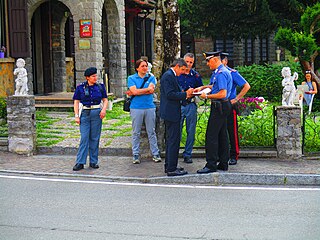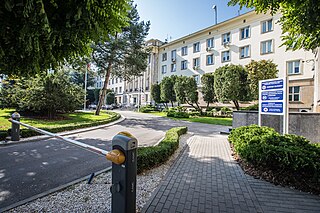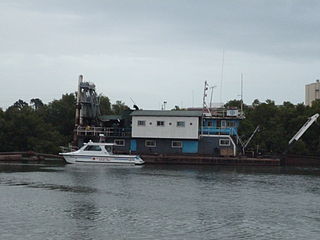
Arturs Krišjānis Kariņš is a Latvian politician who served as the prime minister of Latvia from 2019 until 2023. A linguist and businessman by profession, he previously served as Latvia's minister of Economics and a Member of the European Parliament. Born in Wilmington, Delaware, United States, to parents who had left Latvia during the Soviet occupation, he was active in the American Latvian community throughout his youth.
Law enforcement in Azerbaijan comes under the control of the Ministry of Internal Affairs of Azerbaijan, which administers the National Police of the Republic of Azerbaijan. Admitted to the Organization for Security and Co-operation in Europe (OSCE) on 30 January 1992, with an OSCE office opening in Baku on 16 November 1999. It is a member of INTERPOL.

Italian crime rates, though low compared to other developed countries, are present in various forms throughout the nation. Violent crimes, which include instances of murder, sexual violence, and assault, are quite rare in Italy evidenced by its homicide rate of 0.51 in 2021, the lowest in Europe aside from Luxembourg and Slovenia. However, Italy is notorious for its organized crime groups, which are present worldwide and collectively referred to as the Mafia. This has made financial crimes such as corruption, theft, and trafficking more widespread in the country.

Crime in Brazil involves an elevated incidence of violent and non-violent crimes. Brazil's homicide rate was 27.4 per 100,000 inhabitants, according to the United Nations Office on Drugs and Crime (UNODC). Brazil has the highest number of intentional homicides in the world, with 57,358 in 2018. In recent years, the homicide rate in Brazil has begun to decline. The homicide rate was 20.64 per 100,000 in 2020 with 43,879 killings, similar to 2019, but down from 30.67 per 100,000 in 2017.

Crime in Afghanistan is present in various forms, and includes the following: corruption, contract killings or assassinations, bombings, kidnapping, drug trafficking, money laundering, black marketeering, and ordinary crimes such as theft and assault.

Crime in Russia refers to the multivalent issues of organized crime, extensive political and police corruption, and all aspects of criminality at play in Russia. Violent crime in Siberia is much more apparent than in Western Russia.
Despite a reportedly low crime rate in China, crime still occurs in various forms. The Chinese government does not release exact unified statistics on crime rates and the rate of criminal offending due to such information being considered politically sensitive. Scarce official statistics released are the subject of much academic debate due to allegations of statistical fabrication, under-reporting and corruption. The illegal drug trade in China is a significant driver of violent crime, including murder.

Crime and violence affect the lives of millions of people in Latin America. Some consider social inequality to be a major contributing factor to levels of violence in Latin America, where the state fails to prevent crime and organized crime takes over State control in areas where the State is unable to assist the society such as in impoverished communities. In the years following the transitions from authoritarianism to democracy, crime and violence have become major problems in Latin America. The region experienced more than 2.5 million murders between 2000 and 2017. Several studies indicated the existence of an epidemic in the region; the Pan American Health Organization called violence in Latin America "the social pandemic of the 20th century." Apart from the direct human cost, the rise in crime and violence has imposed significant social costs and has made much more difficult the processes of economic and social development, democratic consolidation and regional integration in the Americas.

Crime in Poland refers to the incidence, deterrence, and handling of criminal activity in the Republic of Poland by Polish law enforcement agencies charged with ensuring public safety and maintaining order. Poland ranks favorably in terms of public safety, with one of the lowest homicide rates in Europe. Poland was ranked 25th in the 2022 Global Peace Index and scored 0.0 on the 2023 Global Terrorism Index.

The crime rate in Oman is low compared to other industrialized countries. Incidents of serious crime are rare in the country. Incidents of petty crime are occasionally reported, including burglary and theft of property of foreign tourists. The Foreign and Commonwealth Office (FCO) describes the law and order situation in Oman as "generally good". Incidence of street crime is low. Violent crime occurs, but is extremely low compared to the rest of the Middle East.

Slovakia is a Central European country with a history of relatively low crime. While crime became more widespread after the Revolutions of 1989, it remains low when compared to many other post-communist countries.

Overall, rates of crime in Spain are relatively low in comparison to other European countries, with the notable exception of robberies. In 2022 it was listed as number two out of 35 states in Europe with regard to the number of police-recorded robberies relative to population size, although in 2020 it had a lower homicide rate than the European Union average.

Crime in Germany is handled by the German police forces and other agencies.
Crime in Denmark is combated by the Danish Police and other agencies.
The Romanian mafia or Romanian organized crime is the category of organized crime groups whose members are citizens of Romania or living abroad in the Romanian diaspora. In recent years they have expanded their criminal activities in the European Union, reads a Europol report on EU organized crime, being active mostly in Italy, Spain and the United Kingdom. The Romanian Mafia is composed of several major organized groups, which in turn have wider networks throughout Europe and have even reached as far as North and Central America.

Crime is present in various forms in the Philippines, and remains a serious issue throughout the country. Illegal drug trade, human trafficking, arms trafficking, murder, corruption and domestic violence remain significant concerns.
Refugees in Poland were, until 2022, a relatively small group. Since 1989, the number of people applying for refugee status in Poland has risen from about 1,000 to 10,000 each year; about 1–2% of the applications were approved. The majority of applications were citizens of the former Soviet Union.
Organised crime in Indonesia refers to planned crimes in Indonesia that could be perpetrated by either a political party or Indonesian gangs, also referred to as preman. The illegal activities may include corruption, cybercrime, money laundering, violence, felonies, extortion, racketeering and drug trafficking.

The Belarus–European Union border crisis is a migrant crisis consisting of an influx of coordinated groups of immigrants, mostly from the Middle East and North Africa, to Poland, Lithuania and Latvia via those countries' borders with Belarus. The crisis was artificially caused by Belarus in response to the severe deterioration in Belarus–European Union relations, following the 2020 Belarusian presidential election, the 2020–2021 Belarusian protests, the Ryanair Flight 4978 hijacking and subsequent sanctions on Belarus, as well as the attempted forced repatriation of Olympic sprinter Krystsina Tsimanouskaya from Tokyo, Japan.















